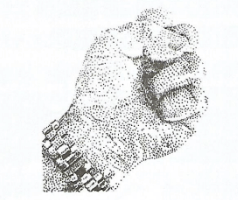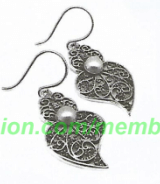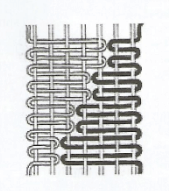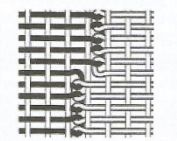QUESTIONS
SECTION A (20 marks)
Answer all the questions in this section in the spaces provided.
-
- Explain two ways of creating harmony in a painting. (2 marks)
- Study the colour wheel below and name the colours labelled (i) to (iv). (2 marks)

- Highlight two characteristics of a good cartoon. (2 marks)
- What is the function of sizing as a step in oil painting? (2 marks)
- Outline two roles of photographic illustrations in graphic design. (2 marks)
- State the significance of mixing clay during its preparation. (2 marks)
- Name four items used as advertising and marketing strategies in graphic design. (2 marks)
- State the importance of an anvil in metal ornamentation. (2 marks)
- Differentiate between applied and structured design in fabric decoration. (2 marks)
- Distinguish between visual and mechanical methods as ways of spacing in lettering (2 marks)
SECTION B (25 marks)
Answer all the questions in this section in the spaces provided.
-
- What is plastic art? (2 marks)
- With reference to the illustration below, explain what you understand by "modelling form using stippling technique (3 marks)

- Explain five steps of marbling technique and dye in one colour using a t-shirt. (5 marks)
-
- Identify the type of sculpture shown below (1 mark)

- Outline four limitations of stone as a material for making soulpture. (4 marks)
- Identify the type of sculpture shown below (1 mark)
- State five guidelines observed when drawing in linear perspective. (5 marks)
-
- Highlight four fundamental steps in the weaving process.
- Use illustrations to explain each of the following tapestry joints:
- Slit
- Interlocking
SECTION C (15 marks)
Answer any one question from this section
- The illustration below shows earrings made from metal

- Identify the technique used to decorate the earrings. (1 mark)
- List two examples of tools used to cut metal. (1 mark)
- Name and explain the method used to join metal in jewellery making. (2 marks)
- Highlight five steps of producing a bamboo beaded necklace. (11 marks)
-
-
- What is a collage in art? (2 marks)
- State three characteristics of collage. (3 marks)
- Mentioning materials and tools, discuss the steps of making a collage composition from imagination. (10 marks)
-
-
- List two substances used to block a screen in printmaking. (2 marks)
- Name and explain two printmaking techniques. (4 marks)
- Using geometric illustrations, explain the term colour separation in reference to printmaking using two colours. (9 marks)
MARKING SCHEME
SECTION A (20 marks)
-
- Two ways of creating harmony in a painting:
- By use of analogous colours/ similar or related colours with a common hue.
- Related themes or subject matters/repetition.
Any 2 x 1-2 marks
- Naming colours labelled;
- Yellow-orange (marigold)
- Yellow green (Lime green/chartreuse)
- Blue-green (cyan/squa)
- Red violet (magenta)
Each 1⁄2 x 4=2 marks
- Two characteristics of a good cartoon;
- Exaggeration of well-known features eg. theial/physical features/ clothing.
- Expresses humour
- have few details/simple.
- Not realistic, representational
Any two correct answers 2 x 1=2 marks
- Function of sizing as a step in oil painting;
- Keeps the oil paint from coming in direct contact with the fib es that make up the
support, - Prevents the oil from destroying the fabric fibres,
- Reduces absorbency of the support
2x1=2 marks
- Keeps the oil paint from coming in direct contact with the fib es that make up the
- Two roles of photographic illustrations in graphic design;
- They capture an emotional component/ attention of the consumer.
- Important part of branding.
- Can easily be manipulated to communicate an idea.
- Improves aesthetics and makes the work stand out.
Any 2 x 1=2 marks
- Significance of mixing clay during its peparation;
Clay is mixed to render it in the right consistency for modelling/so as to achieve the right plasticity/ malleability/homogeneity.
2x1=2 marks - Four items used as advertising and marketing strategies in graphic design are;
Business cards, posters, brochures, calendars, carrier bags, billboards, flyers, rollup stands, packages, branding, catalogues, pamphlets etc.
Any 4x=2 marks - Importance of an anvil in metal ornamentation;
is to provide a hard or tough surface where metal can be hammered and shaped. (Heavy tron block with a flat top and concave sides, on which metal can be hammered and shaped)
2x1=2 marks - Diffe entiate between applied and structured design in fabric decoration;
- Applied-done on top eg printing
- Structured-done at formation stage e.g. weaving
Any 2 x 1=2 mark
- Distinction between visual and mechanical methods as ways of spacing in lettering:
Visual method is using eyes only for measurement. It involves intellectual estimation. Mechanical method is using measurements to do actual measuring of space between letters, words and sentences.
2x1=2 marks
- Two ways of creating harmony in a painting:
SECTION B (25 marks)
-
- Meaning of plastic art;
Art forms which involves physical manipulation of plastic medium by moulding or model- ling such as sculpture or pottery
2x1=2 marks - "Modelling form" using stippling technique refers to use of light and dark value variations of dots to emphasize or create form in 3D"
3x1=3 marks
Total-5 marks
- Meaning of plastic art;
- Five steps of marbling technique in tie and dye using a t-shirt in one colour;
- Crumple the t-shirt, starting at the center, below the neckline, crimping the t-shirt in sections, until its entire body and sleeves are tightly bunched together Secure the gathered t-shirt by binding its edges, one side at a time, with rubber bands/ sisal twine/manila twine.
- Place the t-shirt on sheet of newspaper/ polythene, which will help absorb excess dye during the dyeing process.
- Prepare dye, pour in a bottle, squeeze bottle or sprinkle to wet/soak/drench surface of the t-shirt. When one side is completely covered, flip the t-shirt over genty and cover the other side with the remaining dye.
- Leave the t-shirt to dry, without unbinding the rubber bands, let it stand for a while before unraveling/untying,
Wash the dried t-shirt. Untie the t-shirt and rinse until water is clear ensure all the excess dye has been removed. Leave it to dry,
5x1= 5 marks
-
- The type of sculpture is
high relief.
1 x 1=1marks - Four limitations of stone as a material for making sculpture;
- Heavy and not easy to transport from one place to another.
- Limited to carving only.
- Can easily chip during carving.
- Mistakes made can't be rectified
- Very hard thus a lot of energy required.
Any 4 x 1=4 marks
TOTAL=5 marks
- The type of sculpture is
- Five guidelines observed when drawing in linear perspectives
- Forms nearest the viewer are made clearer and more detailed. but decrease in size further away
- Objects are larger the closer they are and decrease in size proportionally the further away they get.
- All receding horizontal lines converge to a vanishing point on the horizon.
- All vertical lines are perpendicular to the eye level/horizon.
- The horizon is at the viewers' eye level.
5x1-5 marks
-
- Four fundamental steps in the weaving process;
- Warping (set the warps and secure them)
- Create a shed.
- Introduce the weft.
- Interlace the warp and weft.
Each mark 1⁄2 x 4=2 marks
- Explanation of interlocking and slit tapestry joints using Illustrations;
- Slit- wefts create slits between sections of warps usually requiring stitching to join or to close the space.

1x1=1 mark - Interlocking; two different coloured wefts interlock where they meet

2x1=2 marks
Total =5 marks
- Slit- wefts create slits between sections of warps usually requiring stitching to join or to close the space.
- Four fundamental steps in the weaving process;
SECTION C (15 marks)
Candidates to answer any ONE question from this section.
-
- Technique used to decorate the earrings is
filigree technique
1×1=1 mark - Two examples of tools used to cut metal:
- Metal shears.
- Tin snip
- Sharp scissors,
- Pancake dies
- Flush cutter
Any 2×1=2 marks
- Method used to join metal in jewellery making are
- Name: Soldering method
1×1=1 mark - Explain: metal is joined using an alloy which has its own specific melting temperature.
1 × 1=1 mark
Total = 2 marks
- Name: Soldering method
- Five steps of producing a bamboo beaded necklace;
- Gather bamboo sticks of different size cutting, scrapping, shaping, filing and Make holes on the beads and decorate as desired by either painting, carving. varnishing or burning; let them dry and make a variety of beads by splitting. sanding to smoothen
- Make holes on the beads an decorate as desired by either painting, carving, varnishing or burning; let them dry.
- Measure and cut a beading string then fasten both ends
- Attach jump rings to each end of the string and a lobster clasp to one of the
ends. - String the beads according to the design until completion!"
Any five steps sequentially explained as highlighted = 1 marks
- Technique used to decorate the earrings is
-
- Collage in art refers to a piece of art made by sticking different materials cut out such as photographs, pieces of paper or fabric on to a backing/support OR Process of gluing and assembling various cut out materials onto a flat surface
2 × 1=2 marks - Three characteristics of collage;
- Use 3D objects/has a 3D effect
- Has a textural effect
- Can be combined with drawing or painting.
- Uses range of materials/variety of materials, which are cut out and pasted onto a support.
3×1=3 marks
- Collage in art refers to a piece of art made by sticking different materials cut out such as photographs, pieces of paper or fabric on to a backing/support OR Process of gluing and assembling various cut out materials onto a flat surface
- Steps of making a collage composition from imagination, mentioning materials and tools
- Plan and sketch the composition.
- Fold, cut or tear the textured materials using a pair of scissors or a Stanley knife or blade or cutter
- Plan and assemble the cut out materials according to the colour scheme
- Transfer the sketch onto the support/collage base
- Glue and stick the materials onto the support starting from the background and working forward.
- Superimpose and juxtapose the materials creatively
- Crumple or fold the materials as they are stuck to achieve different effects
- Using a brush paint part of the composition where necessary.
- Leave the work to dry
- Einish; mount and frame.
Steps sequentially explained as highlighted=10 marks
Total=15 marks
-
- Two substances used to block a screen in printmaking:
Wax, varnish, shellac, photo emulsion.
Any 2×1=2 marks - Naming and explaining two printmaking techniques;
- Serigraphy-printing through a surface eg. screen and stencil".
- Relief printing from raised surface e.g. block printing,
- Intaglio printing from a sunken surface eg. etching
- Lithography-printing from a flat surface
Any 2×2=4 marks
- Explanation of the term colour separation in reference to printmaking using two colours:
This refers to breaking down the design to the individual colour components/ the process of isolating each colour/ separating a picture by colours in order to make negatives and plates for colour printing
2×2=2 marks
Illustrations of colour separation as used in printmaking
Any relevant illustration 2 × 2=4 marks- All areas with the green colour on the design are separated traced put in one stencil and cut or traced on a screen and all other areas blocked with either varnish, shellac or photo emulsion.
- All areas with orange colour are also seperated, traced in a second stencil, cut or traced on a screen and negative areas blocked with either shellac, varnish or photo emulsion
- Printing can then commence
Explanation of colour separation process=3 marks
Total=9 marks
TOTAL =15 marks
- Two substances used to block a screen in printmaking:
Download Art And Design Paper1 Questions - KCSE 2022 Past Papers.
Tap Here to Download for 50/-
Get on WhatsApp for 50/-
Why download?
- ✔ To read offline at any time.
- ✔ To Print at your convenience
- ✔ Share Easily with Friends / Students
